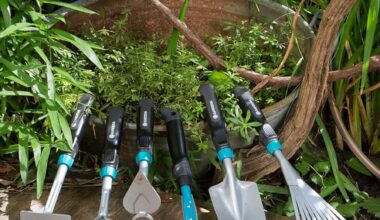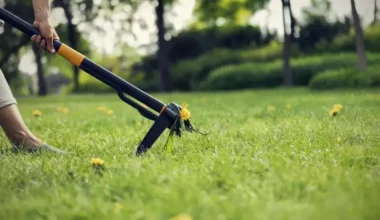Are you overwhelmed by the many pruning tool options? The right tool can greatly improve your garden’s health and look.
Pruning is key for gardeners, and the right tools matter a lot. Pruners and loppers are top choices, each with special features. Knowing their differences will help you choose the best for your garden.
This guide will show you the main differences between prunners vs loppers. It will help you pick the best tool for your garden, whether it’s a hand pruner or a folding saw.

The Difference: Prunners vs Loppers
Choosing between pruners and loppers can greatly affect your gardening work. Pruners are best for small, delicate stems and branches. Loppers are for thicker, larger growth.
Loppers are great for cutting stems and branches up to 1 1/2 to 2 inches thick. They’re perfect for pruning medium to large stems. On the other hand, manual hedge shears cut multiple stems at once. They help shape plants efficiently.
Use bypass loppers for cutting medium to large stems and smaller branches. Hedge shears are better for plants like Shasta Daisy, lavender, and campanula, but use a hand pruner for more precision. Loppers come with bypass or anvil cutting systems, offering flexibility.
The main difference between loppers and hedge shears is their cutting style. Loppers use one blade for cutting, while shears cut with two edges at once, which include different cutting mechanisms. You need both hands to use bypass loppers for efficient cuts.
Choosing between pruners and loppers depends on your garden’s needs. Knowing the differences helps you pick the right tool for the job. This ensures your gardening tasks are done well and quickly.
Blades and Mechanisms Explained
Pruners and loppers come in bypass or anvil types. This depends on their blades and how they cut. Bypass pruners and loppers cut with two sharp blades that slide past each other. Anvil pruners and loppers use a sharp blade that presses against a flat surface to cut.
Bypass pruners and loppers are best for live, green wood. They make clean cuts that help the plant heal and grow back. Anvil pruners and loppers are better for dead, dry wood. They can cut thicker branches without harming the plant.
Some pruners and loppers have ratcheting mechanisms. This makes cutting easier for people with less hand strength or for hard-to-cut wood.

Anvil Pruners: A Closer Look
Anvil pruners are a special type of pruning tool. They have a sharp blade that closes on a flat metal surface, or anvil. This design is great for cutting through hard, dead branches and stems.
Design and Function of Anvil Pruners
The anvil design gives a strong, slicing action. The blade cuts into the material, and the anvil crushes it as the blade goes down. This is perfect for cutting dead wood and woody parts that are hard to cut.
Best Uses for Anvil Pruners
Anvil pruners are great for several tasks:
- Cutting through dead branches and woody stems
- Pruning dead wood on plants and shrubs
- Deadheading annuals and removing spent flowers
These trimmers are a top choice for gardening equipment when dealing with hard plant material. But, they might not be the best for making precise cuts on living plants. They could harm delicate tissues if the wrong tool is used.
Bypass Pruners: Precision and Delicacy
Bypass pruners are a top choice for gardeners who need precise and delicate pruning. They have two sharp blades that move like scissors, cutting through plants smoothly. These pruners are perfect for trimming roses, cutting flowers, and clipping herbs.
Understanding Bypass Pruners
Bypass pruners are great because they make clean cuts without harming the plant. The blades cut stems and branches in a way that helps plants heal quickly. This makes them ideal for trimming live plants without causing damage, especially when using bypass loppers.
When to Use Bypass Pruners
- Pruning roses and other delicate plants
- Cutting fresh flowers for bouquets
- Snipping herbs like basil and thyme
- Trimming perennials and annuals with single stems
- Doing precision pruning on small trees and shrubs often requires a good hand pruner.
Using bypass pruners helps your plants heal fast and stay healthy. They are a must-have for any gardener, whether you’re just starting or have years of experience. Adding bypass pruners to your gardening tools can greatly improve your plant care.
Factors to Consider When Choosing Pruning Tools
Choosing the right trimming tools is important for your gardening. Think about the size and type of plants you’re trimming, how far you need to reach, and any personal needs. Also, consider the quality of the blade, how much it can cut, its design for comfort, and safety features.
Look at the blade material and how it’s made. Different blades are made from stainless steel, forged steel, or high carbon steel. Each type has its own strengths, like sharpness and resistance to rust. Titanium-coated blades are great because they’re sharp, durable, and don’t rust easily.
How much you can cut with your tools matters too. Pruners for trimming fruit trees and shaping shrubs usually cut up to 1 inch. Loppers are better for bigger plants and trees, cutting up to 2 inches. Tools that are easy to hold and light can also make pruning less tiring.
Safety is key when picking trimming tools. Look for tools with a safety lock to prevent accidents. A sap groove keeps the blades clean, stopping them from sticking and spreading diseases.
Other good features include:
- preset cutting positions
- precise adjustment,
- and a notch for cutting wire.
Having parts, you can replace means your tools will last longer. Think about these factors to pick the best pruning tools for your garden. This way, you’ll keep your plants healthy and your garden looking great.
Proper Use and Maintenance of Pruning Tools
Keeping your pruning tools in good shape is key to their effectiveness and longevity. Using them correctly and cleaning and sharpening them regularly can make them last longer. This also makes pruning easier and better for you.
Positioning and Techniques
It’s important to stand comfortably and balanced while pruning to avoid getting hurt. Don’t prune overhead as it can be hard on your body. Try to stand in a way that lets you make clean cuts at an easy angle.
Keep your arms close to your body and move smoothly with your pruners or loppers. This helps you make precise cuts without straining.
Cleaning and Sharpening Guidelines
Cleaning and sharpening your pruning tools regularly keeps them working well. After each use, clean the blades with a cloth and some solvent or rubbing alcohol. This removes sap, dirt, and other stuff that can make the blades stick or dull.
To sharpen your tools, use a fine-grit file or whetstone. Make sure to sharpen along the blade’s bevel to avoid taking off too much metal. A sharp tool cuts cleanly and safely, protecting your plants.
By using your tools correctly and following cleaning and sharpening tips, they’ll stay in great shape. This makes gardening tasks easier and more effective.

Conclusion
Choosing between pruners and loppers can make a big difference in how well you care for your garden. Pruners are perfect for delicate work on live plants, helping them heal quickly after trimming. On the other hand, loppers are great for tackling thicker branches and tougher jobs, making it easier to prune medium to large stems efficiently.
Understanding these tools and picking the right one for each task ensures your plants stay healthy and your gardening is more effective. By mastering how to use and maintain your pruners and loppers, you’ll enjoy a garden that looks great and thrives year-round.




